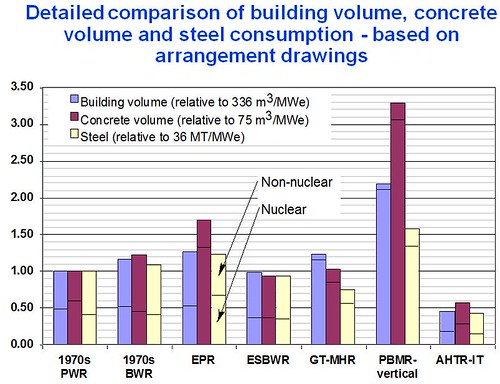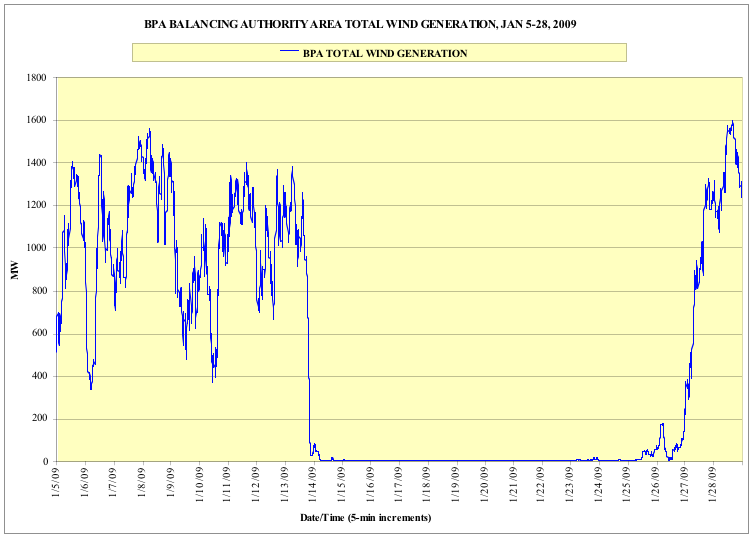Vestas Wind Systems, is a Danish wind turbine manufacturer. In January 2011, Vestas published a report titled Life Cycle Assessment of Electricity Production from a V112 Turbine Wind Park. Within this report's boring and tedious pages are found some of the deepest secrets of the wind industry. "Life Cycle" contains a detailed account of the materials inputs for a 100 MW wind farm. The 100 MW is a nominal rating based on the use of 33 Vestas V112 wind generation systems in a theoretical facility. Each V112 is rated at 3 MW, although its actual output will varie from 0% to 100% depending on wind conditions. Average V112 output can also varie with location.
The report breaks down the materials input by component. Thus the wind turbine mechanisms and towers themselves will require 6634 metric tonnes of Unalloyed or Low alloyed steel and iron, 1442 tonnes of highly alloyed steel, and 2170 tonnes of cast iron. In addition the foundations will require 1491 Tonnes of Steel and iron materials, and 29770 tonnes of Concrete and mortar.
The wikipedia rates the average electrical output - the capacity factor - of wind generators from 20% to 40%. 20% of a 100 MW rated facility is 20 MWs while 40% is 40 MWs. Each V112 requires 355.7 tonnes of steel and iron to construct, or 117.7 tonnes per MW rated capacity. At a capacity factor of 40%, 293 tonnes of iron or steel input will produce one MW of average output, while at a capacity factor of 20%, 587 tonnes are required to produce a MW of average output.
In addition, about 300 tonnes of concrete is used for the tower foundation per every 1 MW of rated generating capacity. At 40% capacity factor that means 750 tonnes of concrete per average MW of output and at 20% capacity factor 1500 tonnes.
There are other significant material inputs into the V112 installation including Aluminum (total 208 tonnes per facility) and Copper (total 176 tons per facility).
Now lets look at another renewables technology, Solar PV. I looked at, A Review of Risks in the Solar Electric Life-Cycle, by V.M. Fthenakis and H.C. Kim of Brookhaven National Laboratory. Those writers reported drawing on date reported by Mason, J. M., V.M. Fthenakis, T. Hansen and H.C. Kim, in "Energy Pay-Back and Life Cycle CO2" Emissions of the BOS in an Optimized 3.5 MW PV Installation. Progress in Photovoltaics: Research and Applications, the report materials input for 1 MW on nominal PV generating capacity. These include 40 metric tonnes of steel per MW, 19 tones of Aluminum, 76 tons of concrete, 85 tonnes of glass, and 13 tons of silicon.
The Wikipedia reports capacity factors of from 12% to 19% for solar PV instalations. This would yield between 120 and 190 kWs of average output for every 1 MW of installed PV power. This would require an input of between 333 and 210 tonnes of steel and between 633 and 400 MT of Concrete per MW of average electrical output. The input of other material into the Solar PV instalation would be equally impressive.
Discussions of the future of energy should focus on costs and resource availability. Switching the world energy system from fossil fuels to post carbon energy technology will be a massive undertaking, that will require huge inputs of materials and labor, whatever energy technology is chosen. Yet the choice of technology is important because the cost of labor and materials inputs matters. Per Peterson illustrates the problem by a comparison of some material inputs for various nuclear technologies:

PBMR is a gas cooled Pebble Bed Modular Reactor while AHTR-IT refers to a molten salt cooled graphite moderated reactor that could use pebble bed technology. Peterson's graphic nicely demonstrates why Pebble Bed Technology, once viewed as very promising has ceased to be viewed as an important nuclear option. Yet pebble bed research has not been entirely wasted. Professor Peterson believes that all of the materials input problems of Pebble Bed Technology. AHTR-IT refers to molten salt cooled graphite moderated reactors that have similar featurs when compaired to MSRs.
In "Metal And Concrete Inputs For Several Nuclear Power Plants," Per F. Peterson, Haihua Zhao, and Robert Petroski of the University of California, Berkeley, reviewed the concrete and steel inputs requirements of several nuclear designs. They stated,
The construction of existing 1970-vintage U.S. nuclear power plants required 40 metric tons (MT) of steel and 90 cubic meters (m3) of concrete per average megawatt of electricity (MW(ave)) generating capacity, when operated at a capacity factor of 0.9 MW(ave)/MW(rated) . . .Peterson and his associates stated that,
In nuclear energy systems, the major construction inputs are steel and concrete, which comprise over 95% of the total energy input into materials. To first order, the total building volume determines total concrete volume. The quantity of concrete also plays a very important role in deciding the plant overall cost:Peterson and associates explain the AHTR,
• Concrete related material and construction cost is important in total cost (~25% of total plant cost for 1970’s PWRs [3]);
• Concrete volume affects construction time;
• Rebar (reinforcing steel in concrete) is a large percentage of total steel input (about 0.06 MT rebar per MT reinforced concrete for 1970’s PWRs [3]);
• Rebar is about 35% of total steel for 1970’s PWRs [3];
• Concrete volume affects decommissioning cost.
The AHTR is a new reactor concept that combines four technologies in a new way: coated particle nuclear fuels traditionally used for helium cooled reactors, Brayton power cycles, passive safety systems and plant designs from liquid cooled fast reactors, and low pressure molten salt coolants [14]. The new combination of technologies may enable the development of a large high efficiency, lower cost high temperature (700 to 1000oC) reactor for electricity. As the peak reactor coolant temperatures approach 700oC, several technologies (Brayton cycles, passive reactor safety systems, available materials, etc.) work together to improve total system performance while significantly reducing costs relative to those for other reactors.Peterson estimates that the steel and iron input for a 1235 MWe AHTR facility to be around 19348 tonnes of metal with some where between 10% and 20% being non ferrous metals, or about 16 MTs per rated MW or 18 MTs per MW of average output. Concrete input would be 184354 cubic meters. Which comes to somewhere close to 424000 MT of concrete, or 343 MT per rated MWe, or around 380 MT of concrete per average MW of output.
The resulting analysis shows that each region has the technical resources to balance large shares of variable renewable energy.
Potentials range from 19% in the least flexible area assessed (Japan) to 63% in the most flexible area (Denmark). The IEA also assessed the resources of the British Isles (Great Britain and Ireland together), 31%; the Iberian Peninsula (Spain and Portugal together), 27%; Mexico, 29%; the Nordic Power Market (Denmark, Finland, Norway and Sweden), 48%; the Western Interconnection of the United States, 45%; and the area operated by the New Brunswick System Operator in Eastern Canada, 37%.



![[EIA+-+Estimated+Levelized+Cost+of+New+Generation.jpg]](https://blogger.googleusercontent.com/img/b/R29vZ2xl/AVvXsEhA4RsjsrAyE4QV5YrX9YlsxHnbHxVr7zrrTLxUq5BdXFPep44u55Rdd9y06Y0-yYPd_G-K_ZCAF8WSSF4cV5Z-6oU9BCIvrUVfFqQH-JSPBkVWqx6O5Y9NgD7d1uqFfQZr2KkTD0wRX08d/s1600/EIA+-+Estimated+Levelized+Cost+of+New+Generation.jpg)













